Class 12 English Chapter 3.2 Do Schools Really Kill Creativity? (Mind-Mapping) Question Answer Maharashtra Board
Balbharti Yuvakbharati English 12th Digest Chapter 3.2 Do Schools Really Kill Creativity? (Mind-Mapping) Notes, Textbook Exercise Important Questions and Answers.
12th Std English Chapter 3.2 Brainstorming Question Answer
12th English Digest Chapter 3.2 Do Schools Really Kill Creativity? Textbook Questions and Answers
Question 1.
Observe the given figure and complete the activities that follow:

(a) Replace the ‘main idea’ by any other thought or title of your own.
(b) Add three supporting ideas to the main idea as their branches.
(c) Add two ideas to one of the branches that explains the meaning of the branch.
Answer:
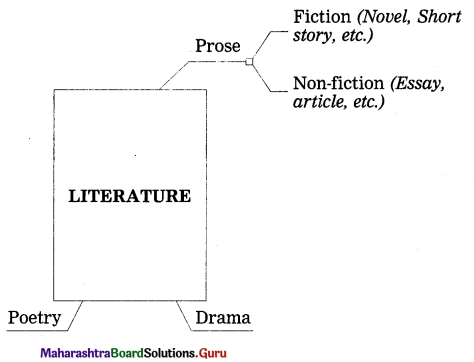
![]()
Question 2.
Complete the given blank spaces/balloons with your ideas in the figure that describes your basic preparation for the HSC Board Examination. Also complete the activities that follows:

Answer:
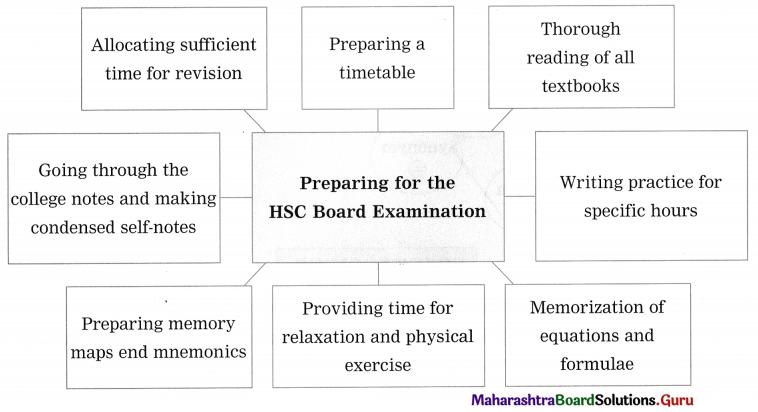
Activity:
Complete a similar type of detailed graphical figure in your own style showing the thoughts/ ideas/concepts that keep on generating in your mind and then you choose a particular style/design or a graphical representation to describe the same idea/facts/situations – then this type of presentation can be called ‘Mind – Mapping.’
Use different shapes, arrows, lines, connectors, balloons, boxes, curved arrows, callouts, scribbles, scrolls, explosions, etc. to describe your point of view.
For example:


![]()
(A1)
Question 1.
Study the tabular column given on page 141 of the Textbook. In pairs, tell your partner the importance of each one: (The first one is given here as an example. Students may attempt 2 to 8 on their own in a manner akin to the one given below.) Enhance activities with Mind-Mapping.

Answer:
- Student A: How does mind – mapping help us?
- Student B: It helps us see an overall picture.
- Student A: Would you kindly explain it a bit more?
- Student B: See, as one would expect, mind – mapping conveys the whole idea through hierarchy and relationships.
- Student A: By the way, what is ‘hierarchy’?
- Student B: Hierarchy is a system in which classes, status, authority, etc. are ranked one above the other.
- Student A: I think I’ve got it. With the help of mind – mapping we ‘maps out’ the points beginning from the more important ones and going on to the less important ones.
- Student B: Exactly! It is a sort of branching out. What I find exciting is that the ‘mapping out’ originates from our brain quite spontaneously.
- Student A: Being the creators we grasp it fully, don’t we?
- Student B: Yes, we do. Now you got it fully right!
(A2)
Question 1.
Given below is a ‘Mind – Mapping’ template. Use your ideas/thoughts/concepts to illustrate/develop them. (Develop your ideas in the form of main branch, sub-branches and tertiary branches respectively).
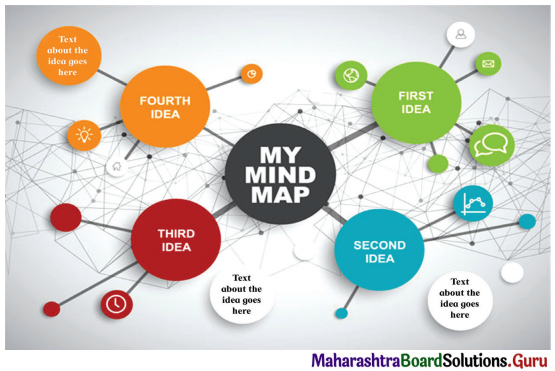
Also, write a paragraph on the mind map you have completed.
Answer:
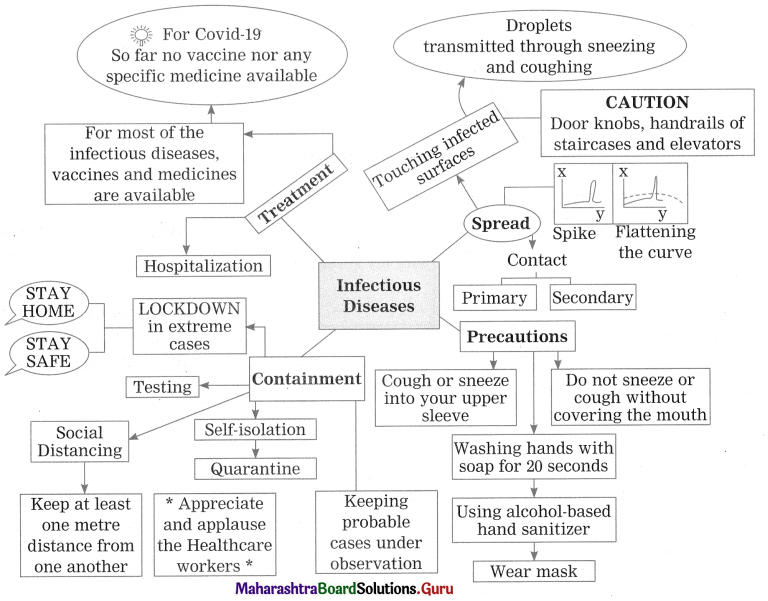
The above given figure is my Mind Map about infectious diseases. The four main ideas are the Spread, Precautions, Treatment and Containment of such infectious diseases. The best way to check the spread of infection is the practice of personal hygiene and social distancing. Maintenance of proper civic sense is called upon from each citizen. Containing the disease becomes a challenge when diseases like COVID-19 breaks out. Lack of vaccine or specific medicine makes the situation very grave. Self-isolation, quarantine, and in extreme situations, Lockdown, etc. are practised to curtail the community spread of the contagion.
A sudden spike in the cases put great strain on the health care system. Authorities try to circumvent the spike by flattening the curve of the spike. Whenever there is a pandemic, it is the duty of the citizens to help the authorities by obeying all the directives.
![]()
(A3)
Question 1.
Develop a ‘Mind – Mapping’ frame/design to show the development in your personality seen with yourself in the last 5 years. You can take the help of the following points in order to develop each of them into further branches:
(Development in Physique, Self-learning Process, Communication Skills, Social Awareness, Family Responsibility)
Answer:
| Development in physique | Self-learning process | Communication skills | Social awareness | Family responsibility |
| A sense of parting with childhood | Began to assess the children around me critically | An awareness of what I speak and how I speak | Still confined to my small world of family and friends | Took everything for granted and never bothered about the resources of my family |
| An earnest desire to join the club of grown-ups | A great quest to know more about the world around me | Censure of incorrect and impolite utterances | Exposure to print and electronic media opened up a ne w world | Slow realisation of the hardships of my parents in educating me |
| A surge in physical energy | An enhanced sense of body ownership | An earnest desire to impress others with my speech | Exploration of the world around me and my place in it | Sibling rivalry to my younger sister gave way to a sense of protective care |
| Interest in sports which are aggressive and dangerous | A sense of bonding with society | Started diary writing and found my skills wanting | Realization that I am not an island floating in the ocean of humanity | Resolved to do well in academics |
| Realization of the passing of adolescence and being an adult | A yearning to invent or discover something new | Level-headed effort to improve my speaking and writing skills | Still trying to figure out the nature of my social commitment | Hope to take great care of my parents in their old age |
(A4)
Question 1.
Develop a ‘Mind – Mapping’ frame/design to show the ‘Benefits of games and sports’ to the students. You can take the help of the following points in order to develop each of them into further branches:
(Fitness and stamina, team spirit and sportsmanship, group behaviour, killer’s instinct, will to win)
Answer:
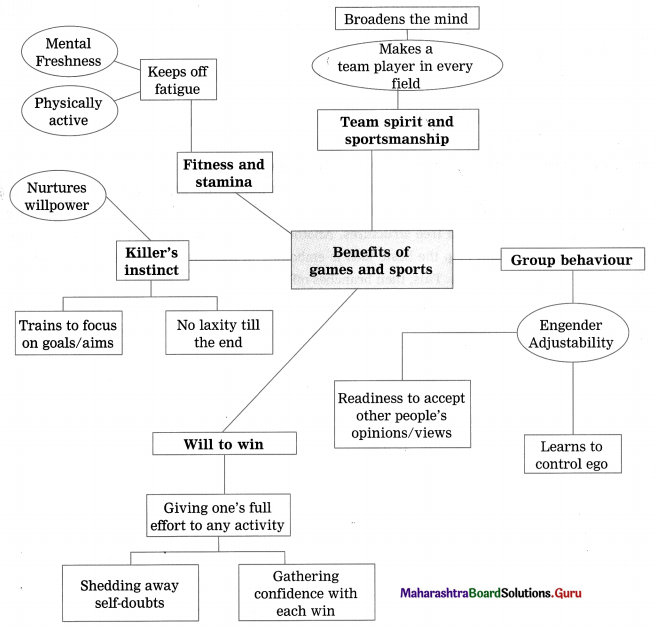
![]()
(A5)
Browse the internet to know the following:
Question 1.
Different Frames/Designs on Mind – Mapping :
(One example is given below. Students may browse the internet to find more.)
Answer:
Spidergram.
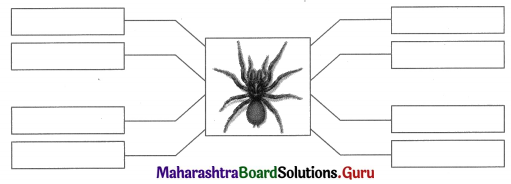
Question 2.
Benefits of Mind – Mapping:
Answer:
Mind – Mapping is an effective tool that helps us capture the logical thinking process that goes on in our mind. It enables us to put pieces of information in the proper slots. The gathered pieces of information then assume a compact and condensed format which can be committed to memory with vividness and clarity. Mind – Mapping also helps generate a stream of creative ideas. The speed and spontaneity of Mind – Mapping proves to be a great advantage during brainstorming sessions.
Question 3.
Uses of Mind – Mapping in note-taking:
Answer:
Mind – Mapping is a creative way of note-taking. We do not remain just passive listeners noting down points mechanically. On the contrary, Mind – Mapping helps us put our creative selves in the process. Thus, we become the co-producers of the information. Using Mind-Mapping in note-taking also enables us to structure the information to suit our natural inclinations of arrangement.
![]()
Question 4.
Difference between Mind – Mapping and Concept Mapping:
Answer:
A Concept map is a diagram that shows the suggested relationships among concepts. Concept maps, unlike Mind maps, allow more divergence due to their multiple hubs and clusters. Mind maps are often restricted to radial hierarchies and tree structures. Another feature that distinguishes a Mind map from a Concept map is that in a Mind map the basic idea is embodied in the centre image and the main themes radiate from the centre as branches. This, then branches off further as twigs.
Yuvakbharati English 12th Digest Guide Section 3 (Writing Skills)